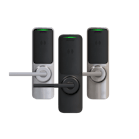COVID-19 Changing the Game for Access Control
The COVID-19 pandemic has had a big effect on the security industry already and should continue to affect it for some time. Not all of this necessarily is bad, says Peter Boriskin, chief technology officer of ASSA ABLOY Americas.
“When you think about it, COVID accelerated a lot of the future,” he says. “Students and coworkers might have one web conference a week [before the pandemic]; now they have eight or 10 a day. A lot of people are teleworking. From a technology standpoint, we’re jumping 5-plus years ahead of where we’d be had we not had this pandemic.”
One obvious manifestation of this is touchless access. The security industry already has seen a huge demand in electronic access control (EAC) systems that make it so people don’t have to touch a door as often, if at all, to enter, exit or move about a facility.
This move not only is happening in tried-and-true security applications, such as offices and hospitals, but also schools, universities and multifamily residences. Several manufacturers of wireless EAC systems say that because wireless systems have a lower cost than wired systems, small businesses, such as rural hospitals and municipal airports, now are implementing wireless systems to add touchless access to their facilities.
Another manifestation is in using the existing technology in new ways, Boriskin says. He points to the Employee Social Distancing program rolled out by HID Global, a division of ASSA ABLOY. The program uses BluFi gateways that communicate with Bluzone cloud-based monitoring software via Wi-Fi wireless connectivity and BEEKs beacons through Bluetooth Low-Energy (BLE) wireless connectivity. The gateways are either AC models that plug in to any standard outlet or DC models that are powered either by a rechargeable battery or hardwired power.
The system was intended to manage products in a warehouse, campus or factory. Now, it’s being used to manage people. When workers carry a BEEKs BLE credential with them, that credential sends a signal to the gateway and monitoring software when it’s within six feet of another BEEKs credential. If two people are too close together, the credential emits an audible and visual alert and sends a record to the Bluzone software.
Boriskin says facilities can use wireless EAC systems to perform similar tasks. Because information from locks and credentials can be collected and processed in real time, companies or, particularly, schools can implement safety protocols on the fly. For example, a company could restrict occupancy to a room to a certain number by quickly updating credentials to prevent access. Or it could perform contact tracing through instant audit-trail reporting in case an employee were ill.
“The best way to enforce policy is through access control,” he says. “It’s a physical manifestation of those policies. Whatever the policy, you can write the policy into the access management system, and it extends to all doors and drawers and lockers and gates.
“I think we can take advantage of networks for access control for other purposes now and put them to use for critical new challenges.”
In other words, more applications are coming.
Will Christensen | Senior Editor
Will Christensen is senior editor at Locksmith Ledger International. He has been an editor and reporter at magazines and newspapers for more than 30 years.






